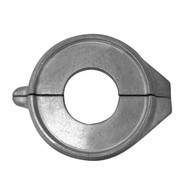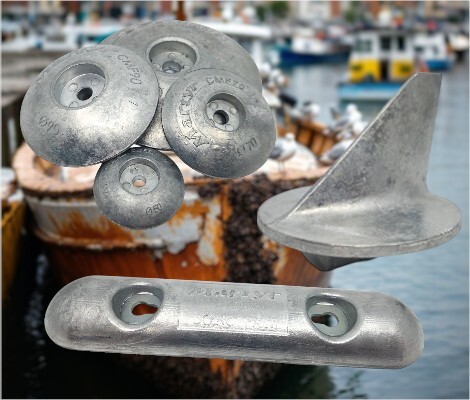Zinc Anodes in Marine Engines: Corrosion Protection & Replacement Guide
6th Jul 2025
Galvanic corrosion is a silent but powerful enemy of marine engines and underwater components. Zinc anodes are your boat’s first line of defence—sacrificial protectors that prevent expensive damage. This guide explains how they work, why they matter, and how you can replace them yourself using quality parts from BoatersWorld.
What is a Zinc Anode & Why It Matters
A zinc anode is a sacrificial metal piece installed on your engine’s underwater drive to attract corrosive electrical currents, protecting more expensive metal components like shafts and drive housings. In saltwater, stray currents attack unprotected metals—zinc gives its electrons instead, saving your engine and drive system.
Without regular anode maintenance, you risk:
- Corrosion of sail drives or sterndrives
- Cavitation on prop shafts
- Seized units that cost thousands to repair
Types of Zinc Anodes & Common Volvo Penta Models
Different engine systems use different anode styles—let’s break them down and link you to exact replacements:
Sail‑Drive Zinc Anode (22651246, SD130/SD150)
- Specifically on Volvo Penta sail‑drive units
- Made to resist corrosion underwater
- Get yours here: Aftermarket Volvo Penta 22651246 / 23615636 Sail Drive Zinc Anode SD130 & SD150
Universal Zinc Anode 823661
- A bolt-on zinc fit for many Penta sterndrives and outboard legs
- Suitable for horizontal or vertical mounts
- Available here: Universal Zinc Anode 823661
Other Jet, Shaft & In‑Hull Anodes
- Zinc models are available for other applications – check the Fittings & Anodes category for options.
How to Inspect & Replace Zinc Anodes
Step 1: Identify Your Anode
Locate the anode on your sail drive, sterndrive housing, outboard, trim tabs, transom or prop shaft. Ensure you have the correct part number and alloy material (e.g., 22651246, 823661).
Step 2: Check Wear Level
Replace if it’s worn down to 50% or has sharp edges corroded away. Surface Area is the most critical component on the performance of the anode, once 50% worn you are only getting 50% of the performance.
Step 3: Remove the Old Anode
- Ensure the Boat is turned off and Power is locked off.
- Use proper marine tools to gently remove the anode bolt.
- Keep a cloth to catch any drips or residue.
Step 4: Clean Mounting Surface
Clear old sealant or debris off the base. Light corrosion on the metal mount should be brushed off to ensure contact.
Step 5: Install the New Anode
- Line up bolt holes and torque to spec (approx. 20–25 Nm or check your engine manual).
- Masked application of sealant recommended on threads.
- Ensure good metal-to-metal contact—this is required for sacrificial corrosion to work effectively.
Step 6: Final Checks
Inspect for tight fit, ensure no gaps or movement. After returning the boat to water, recheck torque and anode wear monthly.
DIY vs Professional Installation: Weigh Your Options
- DIY: Ideal if you have hand tools and basic maintenance skills. Saves money and is easy if the boat is lifted.
- Professional: Ideal if you lack tools, torque knowledge, or need to service underwater drives. Pros can pressure-test seals and inspect drives.
Benefits of Regular Anode Changes
Maintaining sacrificial anodes offers long-term advantages:
- Saves expensive metal parts like shafts, housings, and gear boxes
- Prevents unexpected corrosion issues during the season
- Improves resale value when driven components show signs of care
- Offers peace of mind when boating offshore or in corrosive salt & brackish environments
FAQs About Zinc Anode Care
Q: How often should I replace the zinc anode?
Replace when worn to about half of its thickness or 50% wear—usually every 12–24 months depending on conditions.
Q: Can I leave old anodes in place until they’re gone?
No—anodes must be removed and replaced promptly to continue providing protection. Dead anodes offer no protection and can mislead you about the actual condition.
Q: Can I swap a zinc anode for an aluminum one?
Only use materials recommended by your engine manufacturer. Zinc and Aluminum for Salt & Brackish Waters and Magnesium is for Fresh-water only.
Conclusion & Product Links
Zinc anodes are small parts with big importance—protecting your valuable engine and underwater drive from corrosion damage. For Volvo Penta engine owners, taking care of your 22651246 sail‑drive anode or 823661 universal anode is a simple but essential habit.
Shop replacement anodes:
Got questions about your drive system or need fitment advice? Contact Boaters World’s marine experts or visit our service centre for support.

 Australian Dollars
Australian Dollars


